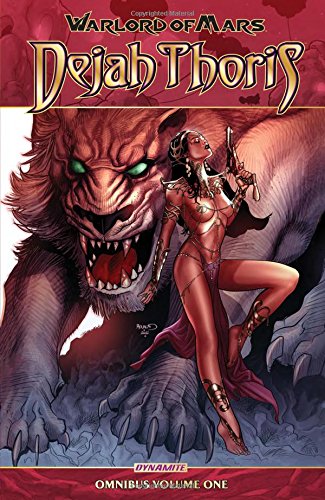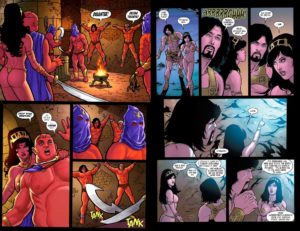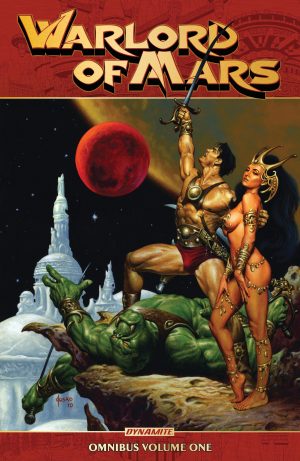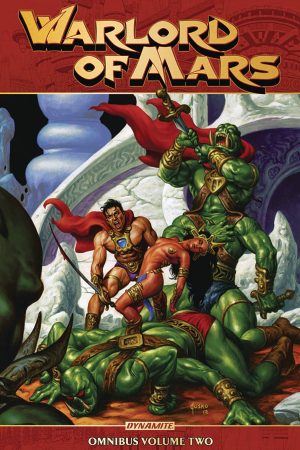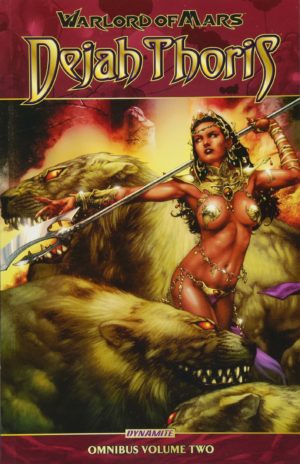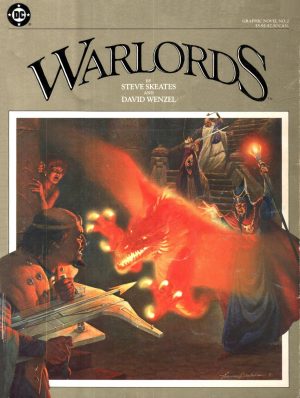Review by Frank Plowright
This Omnibus gathers the first three Warlord of Mars: Dejah Thoris paperbacks, most of the content written by Arvid Nelson and drawn by Carlos Rafael, although some nasty surprises await.
Dejah Thoris was conceived and fleshed out as a fantasy figure in the pre-World War I pulp days by Edgar Rice Burroughs, when she was primarily described in prose accompanied by the occasional illustration, as racy as the times would permit. Drawing her in new adventures means that every page features a near naked ideal of feminine perfection, and that’s a massive step up from text where it mentions her state of undress and moves on. To point out Dynamite’s version of Dejah Thoris is exploitative grossly understates the case, and to many people the objectification of women will be unacceptable.
Dejah is best known as John Carter’s companion, but Burroughs explained she’d lived a long life before meeting him, and these stories are from that life, Nelson having researched the original material to construct them. For all that research, there’s not a great deal of originality about what Nelson produces, which is largely generic fantasy with recognisable archetypes, some stepping beyond that seemingly modelled on better known characters. It’s also disappointing that for all that it’s promoted she’s a strong warrior, Dejah’s purpose is all too often as victim, captured and chained. In the stories Nelson writes she’s also just one of an ensemble cast, very few events actually dependent on her.
Rafael is an artist who improves throughout this collection. He begins with a strong sense of page design, and puts the effort into a consistently buxom Dejah, but his other people are sometimes oddly put together. By the end of the collection his line has become far finer, figurework problems have disappeared, and his layouts have become even more dynamic. The contrast can be seen comparing the two pages of sample art, with the later chapters impressive work on Rafael’s part. His progress may offer some inspiration to Marcio Fiorito whose drawing of the final story is very basic in comparison.
Both Nelson and subsequent writer Robert Place Napton suffer curious lapses of logic regarding their plots. It is eventually explained how a warrior on the verge of death is in perfect health when next seen, but that explanation smacks of an author scrabbling around to rectify the situation once it was pointed out. A story set in the icy wastes has Dejah modifying her near nakedness to the wearing of a cloak as some protection, a ridiculous concession Napton repeats in volume two. Here he also repeats the role of victim for Dejah Thoris, and while her inner personality eventually plays a part, it’s left to a man to save the day. Considering she’s the title character, that she’s all too often ignored or subservient despite being a warrior, speaks volumes about objectification.
Given the exploitative presentation of Dejah Thoris, it’s to be assumed that Dynamite know their audience, and also know that as long as a basic action plot is supplied, there’ll be no complaints. Anyone expecting anything more will be disappointed. A possible alternative is to sample the slimmer paperback volumes first, beginning with Colossus of Mars.
